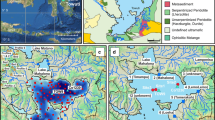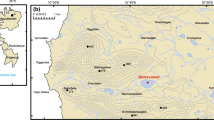Abstract
We examine sediment dynamics in an upland, temperate lake system, Lake Bassenthwaite (NW England), in the context of changing climate and land use, using magnetic and physical core properties. Dating and analysis of the sedimentary records of nine recovered cores identify spatially variable sedimentation rates across the deep lake basin. Mineral magnetic techniques, supported by independent geochemical analyses, identify significant variations both in sediment source and flux over the last ∼2100 years. Between ∼100 years BC and ∼1700 AD, sediment fluxes to the lake were low and dominated by material sourced from within the River Derwent sub-catchment (providing 80% of the hydraulic load at the present day). Post-1700 AD, the lake sediments became dominantly sourced from Newlands Beck (presently providing ∼10% of the lake’s hydraulic load). Three successive, major pulses of erosion and increased sediment flux appear linked to specific activities within the catchment, specifically: mining activities and associated deforestation in the mid-late nineteenth century; agricultural intensification in the mid-twentieth century and, within the last decade, the additional possible impact of climate change. These results are important for all upland areas as modifications in climate become progressively superimposed upon the effects of previous and/or ongoing anthropogenic catchment disturbance.










Similar content being viewed by others
References
Appleby PG, Oldfield F (1992) Application of lead-210 to sedimentation studies. In: Ivanovich M, Harmon RS (eds) Uranium series disequilibrium: applications to earth, marine and environmental sciences. Clarendon Press, Oxford
Battarbee RW, Anderson NJ, Appleby PG, Flower RJ, Fritz SC, Haworth EY, Higgit S, Jones VJ, Kreiser A, Munro MAR, Natkanski J, Oldfield F, Patrick ST, Richardson NG, Rippey B, Stevenson AC (1988) Lake acidification in the United Kingdom 1800–1986. Ensis Publishing, London
Bennion H, Montheith D, Appleby P (2000) Temporal and geographical variation in lake trophic status in the English Lake District: evidence from (sub) fossil diatoms and aquatic macrophytes. Freshw Biol 45:394–412. doi:10.1046/j.1365-2427.2000.00626.x
Bindler R, Renberg I, Brannvall ML, Emteryd O, El-Daoushy F (2001) A whole-basin study of sediment accumulation using stable lead isotopes and flyash particles in an acidified lake, Sweden. Limnol Oceanogr 46:178–188
Blais JM, Kalff J (1995) The influence of lake morphometry on sediment focusing. Limnol Oceanogr 40:582–588
British Geological Survey (1992) Regional geochemistry of the Lake District and adjacent areas. British Geological Survey, Nottingham
Bronk Ramsey C (2005) Improving the resolution of radiocarbon dating by statistical analysis. In: Levy TE, Higham TFG (eds) The bible and radiocarbon dating: archaeology, text and science. Equinox, London
Dankers PH (1978) Magnetic properties of dispersed natural iron oxides of known grain size. Unpublished Ph.D. Thesis, University of Utrecht
Davis MB (1969) Climatic changes in southern Connecticut recorded by pollen deposition at Rogers Lake. Ecology 50:409–422. doi:10.2307/1933891
Davis MB (1976) Erosion rates and land-use history in southern Michigan. Environ Conserv 3:139–148
Davis MB, Moeller RE, Ford J (1984) Sediment focussing and pollen influx. In: Haworth EY, Lund JWG (eds) Sediments and environmental history: studies in palaeolimnology in honour of Winifred Tutin. Leicester University Press, Leicester
Dearing JA (2000) Natural magnetic tracers in fluvial geomorphology. In: Foster IDL (ed) Tracers in geomorphology. Wiley, Chichester
Dearing JA, Foster IDL (1987) Limnic sediments used to reconstruct sediment yields and sources in the English midlands since 1765. In: Gardiner V (ed) International geomorphology 1986 Part 1. Wiley, Chichester
DEFRA (2006) June 2006 Agricultural and Horticultural Survey—England. http://www.defra.gov.uk/esg/work_htm/publications/cs/farmstats_web/2_SURVEY_DATA_SEARCH/COMPLETE_DATASETS/PSM/RegCountUA_06.xls. Retrieved on 8/2/2008
Ficken KJ, Wooller MJ, Swain DL, Street-Perrott FA, Eglinton G (2002) Reconstruction of a subalpine grass-dominated ecosystem, Lake Rutundu, Mount Kenya: a novel multi-proxy approach. Palaeogeogr Palaeoclimatol Palaeoecol 177:137–149. doi:10.1016/S0031-0182(01)00356-X
Flynn WW (1968) The determination of low levels of polonium-210 in environmental materials. Anal Chim Acta 43:221–227. doi:10.1016/S0003-2670(00)89210-7
Hatfield RG, Maher BA (2008) Suspended sediment characterisation and tracing using a magnetic fingerprinting technique: Bassenthwaite Lake, Cumbria, UK. Holocene 18:105–115. doi:10.1177/0959683607085600
Heathwaite AL (1994) Chemical fractionation of lake-sediments to determine the effects of land-use change on nutrient loading. J Hydrol (Amst) 159:395–421. doi:10.1016/0022-1694(94)90269-0
Hulme M, Jenkins GJ, Lu X, Turnpenny JR, Mitchell TD, Jones RG et al (2002) Climate change scenarios for the United Kingdom: The UKCIP02 Scientific Report. Tyndall Centre for Climate Change Research, School of Environmental Sciences, University of East Anglia, Norwich, UK
Lehman JT (1975) Reconstructing the rate of accumulation of lake sediment: the effect of sediment focussing. Quat Res 5:541–550. doi:10.1016/0033-5894(75)90015-0
Likens GE, Davis MB (1975) Post-glacial history of Mirror Lake and its watrershed in New Hampshire, USA, an initial report. Verh Int Ver Theor Angew Limnol 19:982–993
Maher BA (1988) Magnetic properties of some synthetic sub-micron magnetities. Geophys J 94:83–96
Malby AR, Whyatt JD, Timmis RJ, Wilby RL, Orr HG (2007) Long-term variations in orographic rainfall: analysis and implications for upland catchments. Hydrol Sci J 52:276–291. doi:10.1623/hysj.52.2.276
Morrison S (1997) Interpretation of a sediment profile from Bassenthwaite Lake, Cumbria: historical changes in the catchment. Unpublished undergraduate dissertation, Department of Geography, University of Liverpool
Oldfield F, Appleby PG, Thompson R (1980) Palaeoecological studies of lakes in the highlands of Papua New Guinea: I. The chronology of sedimentation. J Ecol 68:457–477. doi:10.2307/2259416
Oldfield F, Battarbee RW, Dearing JA (1983) New approaches to recent environmental-change. Geogr J 149:167–181. doi:10.2307/633601
Oldfield F, Maher BA, Donoghue J, Pierce J (1985) Particle-size related, mineral magnetic source sediment linkages in the Rhode River catchment, Maryland, USA. J Geol Soc London 142:1035–1046. doi:10.1144/gsjgs.142.6.1035
Oldfield F, Crooks PRJ, Harkness DD, Petterson G (1997) AMS radiocarbon dating of organic fractions from varved lake sediments: an empirical test of reliability. J Paleolimnol 18:87–91. doi:10.1023/A:1007985119922
Oldfield F, Wake R, Boyle J, Jones R, Nolan S, Gibbs Z et al (2003) The late-Holocene history of Gormire Lake (NE England) and its catchment: a multiproxy reconstruction of past human impact. Holocene 13:677–690. doi:10.1191/0959683603hl654rp
Orr HG, Carling PA (2006) Hydro-climatic and land use changes in the River Lune catchment, North West England, implications for catchment management. River Res Appl 22:239–255. doi:10.1002/rra.908
Orr HG, Davies G, Quinton J, Newson M (2004) Bassenthwaite Lake geomorphological assessment: phase 2. Unpublished report to the Environment Agency, June 2004
Ozdemir O, Banerjee SK (1982) A preliminary magnetic study of soil samples from West-Central Minnesota. Earth Planet Sci Lett 59:393–403. doi:10.1016/0012-821X(82)90141-8
Parker JE, Lyle AA, Dent MM, James JB, Lawler AJ, Simon BM et al (1999) Investigation into the nature of the material resuspended in Bassenthwaite Lake during mixing episodes. Unpublished report by CEH to the Environment Agency, WI/T11067Q7/2
Postlethwaite J (1913) Mines and mining in the (English) Lake District. Moss, Whitehaven
Ramsbottom AE (1976) Depth charts of the Cumbrian Lakes. Freshwater Biological Association, Cumbria
Reimer PJ, Baille MGL, Bard E, Bayliss A, Beck JW, Blackwell PG et al (2004) IntCal04 Terrestrial radiocarbon age calibration, 26–0 ka BP. Radiocarbon 46:1029–1058
Renberg I (1990) A 126,000 year perspective of the acidification of Lille Oresjon, southwest Sweden. Philos Trans R Soc B 327:357–361. doi:10.1098/rstb.1990.0073
Rose NL (2008) CARBYNET. University College London. http://www.ecrc.ucl.ac.uk/content/view/299/17. Retrieved on 7/2/2008
Rose NL, Appleby PG (2005) Regional applications of lake sediment dating by spheroidal carbonaceous particle analysis I: United Kingdom. J Paleolimnol 34:349–361. doi:10.1007/s10933-005-4925-4
Rosenbaum JG, Reynolds RL, Adam DP, Drexler J, SarnaWojcicki AM, Whitney GC (1996) Record of middle Pleistocene climate change from Buck Lake, Cascade Range, southern Oregon—Evidence from sediment magnetism, trace-element geochemistry, and pollen. Geol Soc Am Bull 108:1328–1341. doi:10.1130/0016-7606(1996)108<1328:ROMPCC>2.3.CO;2
Russell MA, Walling DE, Hodgkinson RA (2001) Suspended sediment sources in two small lowland agricultural catchments in the UK. J Hydrol (Amst) 252:1–24. doi:10.1016/S0022-1694(01)00388-2
Sear DA, Newson MD (1994) Sediment and gravel transport in rivers including the use of gravel traps. Unpublished report to the National Rivers Authority, C5/384/2
Street-Perrott FA, Barker PA, Swain DL, Ficken KJ, Wooler MJ, Olago DO et al (2007) Late Quaternary changes in ecosystems and carbon cycling on Mt. Kenya, East Africa: a landscape-ecological perspective based on multi-proxy lake-sediment influxes. Quat Sci Rev 26:1838–1860. doi:10.1016/j.quascirev.2007.02.014
Telford RJ, Heegaard E, Birks HJB (2004) All age-depth models are wrong: but how badly? Quat Sci Rev 23:1–5. doi:10.1016/j.quascirev.2003.11.003
Thompson R, Morton DJ (1979) Magnetic susceptibility and particle size distribution in recent sediments of the Loch Lomond drainage basin, Scotland. J Sediment Petrol 49:801–811
Thompson R, Oldfield F (1986) Environmental magnetism. Allen & Unwin, London
Thompson R, Battarbee RW, O’Sullivan PE, Oldfield F (1975) Magnetic-susceptibility of lake sediments. Limnol Oceanogr 20:687–698
Van der Post KD, Oldfield F, Haworth EY, Crooks PJR, Appleby PG (1997) A record of accelerated erosion in the recent sediments of Blelham Tarn in the English Lake District. J Paleolimnol 18:103–120
Walling DE, Fang D (2003) Recent trends in the suspended sediment loads of the world’s rivers. Global Planet Change 39:111–126. doi:10.1016/S0921-8181(03)00020-1
Wasson RJ, Mazari RK, Starr B, Clifton G (1998) The recent history of erosion and sedimentation on the Southern Tablelands of southeastern Australia: sediment flux dominated by channel incision. Geomorphology 24:291–308. doi:10.1016/S0169-555X(98)00019-1
Yang HD, Rose NL, Battarbee RW, Monteith D (2002) Trace metal distribution in the sediments of the whole lake basin for Lochnagar, Scotland: a palaeolimnological assessment. Hydrobiologia 479:51–61. doi:10.1023/A:1021054112496
Zolitschka B (1998) A 14,000 year sediment yield record from western Germany based on annually laminated lake sediments. Geomorphology 22:1–17. doi:10.1016/S0169-555X(97)00051-2
Acknowledgements
This research was supported by a Lancaster University 40th Anniversary studentship to RGH. BAM gratefully acknowledges financial support from the Royal Society. We would like to thank Dr. Ian Winfield for the bathymetry data, Victoria Keeton for analysis of water content and dry bulk density on some of the lake cores and Katherine Day for undertaking 210Pb analyses on BASS 5.
Author information
Authors and Affiliations
Corresponding author
Rights and permissions
About this article
Cite this article
Hatfield, R.G., Maher, B.A., Pates, J.M. et al. Sediment dynamics in an upland temperate catchment: changing sediment sources, rates and deposition. J Paleolimnol 40, 1143–1158 (2008). https://doi.org/10.1007/s10933-008-9221-7
Received:
Accepted:
Published:
Issue Date:
DOI: https://doi.org/10.1007/s10933-008-9221-7




